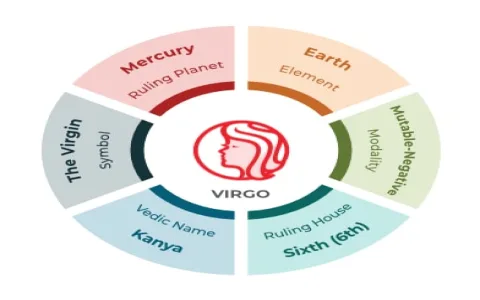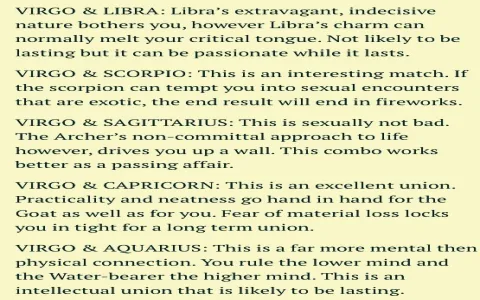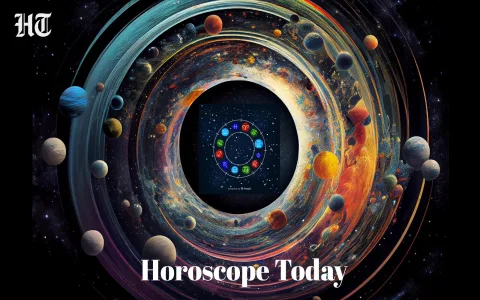Man, let me tell you, I didn’t set out to become a relationship guru or anything. This whole Sag Woman and Virgo Man compatibility deep dive, this was strictly survival. My survival, actually, because if I didn’t figure out why my two closest friends—let’s call them Sarah (Sag) and Mark (Virgo)—were perpetually on the brink of disaster, I was going to lose them both, or at least lose my sanity listening to their epic screaming matches.
Setting the Stage: Why I Jumped Into This Mess
For months, maybe a year, their arguments followed the exact same script. Sarah would pitch some massive, spontaneous, vaguely defined idea—like, “We should sell the car and buy a van to drive across Canada next month!” Mark would immediately counter with spreadsheets, logistics, permits, and a projected gas budget to the penny. The result? Total atomic fallout. She felt stifled; he felt ignored and financially threatened.
I realized that traditional advice wasn’t helping them. They’d read the astrology blogs, they knew the theory—she’s Fire, he’s Earth. But knowing the theory doesn’t stop you from screaming over dirty socks and credit card bills. I decided I had to move beyond the textbook stuff and start treating their relationship like a practical, ongoing lab experiment. I committed to documenting every single fight they had over a three-week period, logging the trigger, the stated disagreement, and the hidden core fear behind it.

Pinpointing the Core Clash Points
The first thing I did was ditch the generic labels. “Freedom vs. Structure” is too fluffy. My logs showed two specific, repeated points of friction that were causing 90% of the damage:
- The Future Planning Paradox: Sarah loves the massive, sweeping vision. She sees the end destination, the joy, the grand narrative. Mark only sees the 30 immediate logistical steps required to get there. They were fighting about whether to launch the rocket (Sag) or whether the nuts and bolts were secured (Virgo). They never discussed the middle ground.
- The Communication Gap: Sarah is brutally honest, expansive, and sometimes hyperbolic. She throws out phrases like, “You always ruin everything!” Mark takes everything literally, meticulously dissects the wording, and gets stuck on the “always.” Her emotional truth was hitting his factual reality, and neither could process the other’s language.
I started noticing that the trigger wasn’t the event (e.g., leaving a pile of dishes); it was the response delay. If Sarah sprung an idea, and Mark didn’t instantly validate the potential fun, she shut down. If Mark presented a well-researched plan, and Sarah dismissed it as “boring,” he felt useless. I had to devise a way to force a translation between their two operating systems.
The Experiment: Testing Communication Hacks
My practice wasn’t about telling them to change who they were; it was about changing the way they packaged their needs. I started small. I intervened strategically on minor disagreements first, using simple, forced framing techniques I’d read about in behavioral psychology books.
For Mark (Virgo Man), the goal was to validate the vision first, then introduce the details later. I told him: “When Sarah pitches a wild idea, your first response must be a genuine, excited sound and three words of pure approval, before you mention any fact.” So, instead of, “That sounds fun, but we need $5,000,” he had to say, “Wow, that sounds amazing! Now, let’s talk about the logistics to make sure it’s the best possible trip.” It sounds silly, but that initial emotional validation calmed her down immediately.
For Sarah (Sag Woman), the goal was to respect the process. I drilled into her head that Mark’s caution wasn’t rejection; it was his way of showing love and wanting quality. I coached her to use translation phrases. Instead of saying, “Your plan is so boring and stifling,” she had to start with: “I trust your ability to organize this, but can we leave 20% of the itinerary completely open for spontaneity?” She started presenting her need for freedom as a necessary design feature, not a revolt against his structure.
This phase was exhausting. I was essentially whispering instructions into their ears mid-conversation. I monitored the results. If they followed the script, the argument ended in 10 minutes with a resolution. If they reverted to old habits, it blew up for two hours. The pattern was undeniable.
The Big Realization and Practical Fixes
What I realized through this whole chaotic practice session is that their disagreements weren’t about values; they were about processing speed and priorities. The Sag woman needs the vision to be accepted first, and the Virgo man needs the method to be respected. They needed a handshake protocol, not a personality transplant.
My core finding, the biggest lesson I extracted and implemented, was to establish a clear “Hand-Off Point.”
Here’s the simple system that finally worked:
- Phase 1: The Vision Phase (Sag Leads). Sarah gets 48 hours to present her grand idea with zero input allowed from Mark regarding cost or feasibility. Mark’s only job is to ask open-ended questions about the feeling of the vision (“What would you feel when we accomplish this?”).
- Phase 2: The Logistics Phase (Virgo Leads). Once the vision is validated, Sarah has to formally “hand off” the idea to Mark. He gets 72 hours to come back with three fully fleshed-out options (A, B, C) ranging from budget-friendly to high-end. Sarah agrees upfront not to criticize the structure, only to pick one of the options.
- The 80/20 Rule: They mutually agreed that in every plan, 80% is structured by Mark, but 20% must be left entirely blank—a pure, unbudgeted, unplanned slot for Sagittarian improvisation. This guaranteed freedom without destroying the entire framework.
It’s still messy sometimes, but the core disagreements—the constant, painful cycle of being hurt by the other’s inherent nature—have mostly vanished. It wasn’t about finding compatibility; it was about building a specialized translation mechanism so the Sag vision could speak Virgo language, and the Virgo detail could speak Sag aspiration. It was a ton of work, but seeing them actually thrive now makes every minute I spent logging their stupid fights feel totally worth it.







